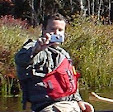 |
| Heading out of West Cove |
Ask Rhode Island sea kayakers what their favorite paddling spot is, and many will say Fort Wetherill. It provides access to a beautiful section of rocky shore that is much like the coast of Maine. From here you can head north to the Dumplings and Jamestown Harbor for great views of the Newport Bridge, or east to Newport and around Brenton Point for rock gardening and coastal touring, or west to Beavertail to enjoy rock gardening along the southern shore of Conanicut Island.
 |
| Paddling in the rocks |
“Rock gardening” or “rock play” involves catching a ride on ocean swells as they weave their way through the rocky shore. There are three factors to consider when paddling between and over rocks. First, what is the route and can I run it in my boat. Second, is there enough water and is it deep enough for the time needed to complete the run. Third, do I have enough time to get through before the next wave hits.
 |
| Staying close to the cliffs |
After a quick warmup on the water we headed out from Fort Wetherill’s West Cove. We paddled close to the cliffs looking for rock play opportunities. We started off easy and moved to more difficult features. By lunch time we were at Horsehead. Tony Moore and I paddled this section in his tandem kayak back to 2018. We paddled into Horsehead late and got trashed by the waves - see 0.49 here. My timing was better this time.
 |
| Run through Horsehead |
We paddled around Shore Point before turning around in Hull Cove. On the way back I stayed out a little further from the rocks taking pictures and getting comfortable paddling in the waves. Once back at Fort Wetherill we did rescue practice. I was the rescuer and the rescuee, and did fine on both. Three tips to remember from this trip - keep your hands wide on the paddle, look where you want to go, and lean forward into a sweeping turn, Mission accomplished on this trip.




No comments:
Post a Comment
Note: Only a member of this blog may post a comment.